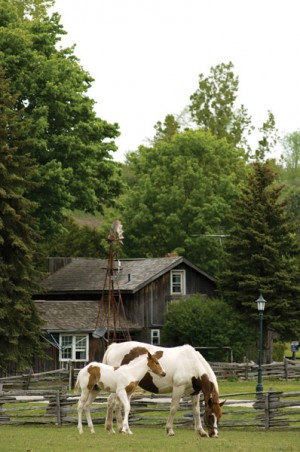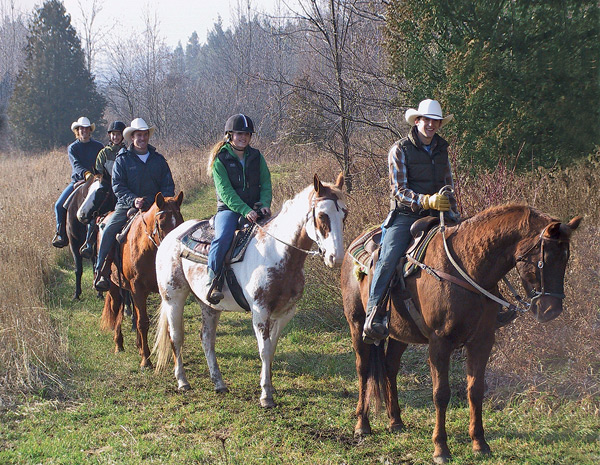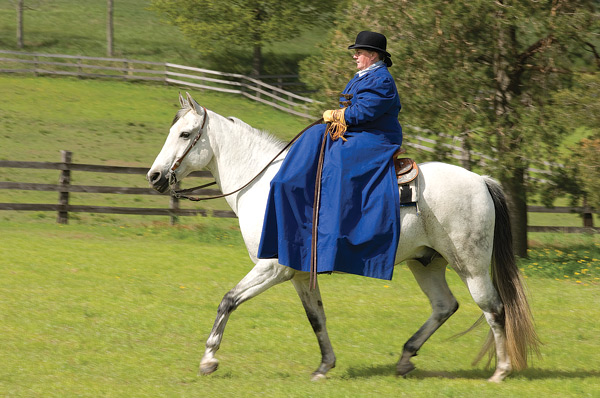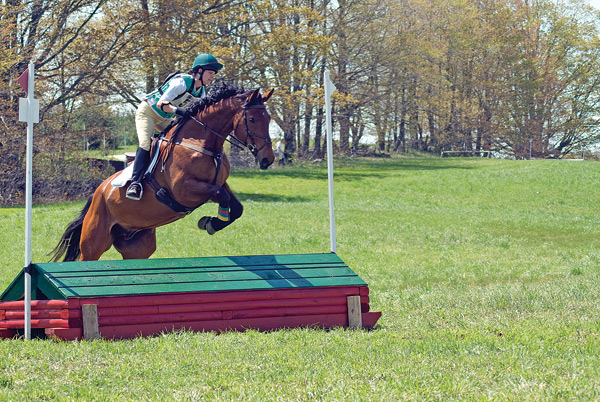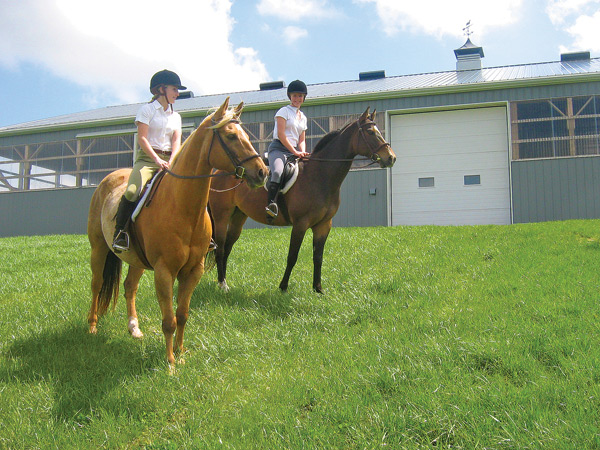Heads Up! The Hills of Headwaters Stable Tour
The Hills of Headwaters Stable Tour will “open the barn doors” to the public for an up-close and personal peek at the region’s horse industry.
Once a sleepy bastion of pony clubbers and eventers, Headwaters is fast becoming the new heart of Ontario’s burgeoning horse industry.
From FEI World Cup show jumping and eventing to grassroots hacking and hay rides, the region serves as home to some of Canada’s finest breeding, training and coaching operations and show facilities. There is something of nearly every breed and predilection to draw local and international horse lovers to the region.
And come September, the first annual Hills of Headwaters Stable Tour will “open the barn doors” to the public for an up-close and personal peek at the region’s horse industry.
More than twenty participating stables will offer activities and demonstrations in everything from riding sidesaddle to carriage driving to calf roping and show jumping. There’s virtually something for everyone – including those who are simply curious! (Some of the region’s most exclusive equestrian estates will be open for viewing.)
The tour is sponsored by the equestrian committee of the Hills of Headwaters Tourism Association. “It’s a window into the industry – people just want to go look at how others do it – and it’s a way of networking for those already in it,” says committee co-ordinator Michele Harris.
“It’s also a way to draw tourists up to the area. There are a lot of people moving to the area because of horses,” she explains. “We’re trying to show how it’s snowballing!”
On this page, we offer a preview of the some of the stables on the tour.
For information about the events, including a map, visit www.horseswww.inthehills.ca or call 1-800-332-9744.
Teen Ranch
Horses help kids learn important life lessons
by Monica Duncan
As a teenager in the 1950s, Mel Stevens was a youth teetering toward rebellion. He credits the positive influence of his father and other strong male role models for keeping him from straying.
Later on, while touring Australia with a gospel music group called The King’s Men, he was asked by friends to help create a Canadian-style outdoor camping experience for at-risk kids. Stevens threw himself into the project and stayed on as camp director of Teen Ranch Australia for seven years.
Back in Canada in the late sixties, Stevens and his wife, Janet, were ready to do it all again. Western riding would be the main focus of the camp, underpinned by the values of a Christian lifestyle. With very modest facilities on rugged acreage they had purchased just south of Orangeville, they held their first summer camp in 1967.
More than forty years later, Caledon’s Teen Ranch is so much more than its sweet, anachronistic name suggests.
Today, the 150-acre ranch is something of a rural paradise of rolling meadows, wooded hills, large ponds, groomed trails and a very busy stable. Now home to more than sixty English and Western horses, the ranch also has tennis and volleyball courts, offers a year-round hockey program in its spacious arena, and holds retreats, spa weekends, father-and-son programs, and more. And it all takes place within a non-denominational context based on Biblical principles and positive role modelling. “We aim for top quality in what we do, especially taking a personal interest in the kids,” Stevens says.
Riding remains very much part of the ranch’s own programs, and it now also hosts numerous schooling and club shows, including a large American Quarter Horse Association event, that include many levels of participation for the developing athlete.
Stevens believes working with horses offers sound training for kids as they develop their ability to meet life’s challenges. Whether a child is frightened or filled with bravado, he says, belief in themselves or in others doesn’t become trust until a rider puts a foot in the stirrup, swings into the saddle, and makes the commitment. It is this kind of gentle challenge, trust in self and grace, that Teen Ranch wants to foster.
“Thirteen and fourteen are crucial ages for kids,” says Stevens. The decisions they make at this time will have lifelong consequences, so ranch leaders are encouraged not to preach at them, but to carefully choose “teachable moments,” helping kids examine the choices they are making. One father was so grateful for this approach, he penned Teen Ranch a nine-page letter, saying his challenged child had never been treated with such attention and that the experience had transformed attitudes for the whole family.
It’s that kind of word-of-mouth testament that has earned Teen Ranch an international reputation. One Russian family recently accompanied their athlete son and personal trainer to hockey camp, saying they’d heard it was one of the best in the world. In fact, the Maple Leafs, Ottawa Senators, Florida Panthers and numerous other professional and world-class athletes make use of the facility.
Throughout it all, Stevens’ ad hoc missionary work through his music persisted. On a tour with The King’s Men in Indonesia in the early 1970s, Stevens visited the slums of Jakarta. Seeing how street children lived, with nowhere to go and selling their bodies and souls, he was inspired to set up yet another camp. Two hours outside of Jakarta, a facility that serves about 800 street children is still operating today, supported in part by Caledon’s Teen Ranch.
Although the ranch now has a staff of thirty full-time employees, supported by some seventy volunteers, it is still very much a family affair. Stevens’ wife Janet died in her early forties, but their four children have carried on with work on the ranch.
Stevens married his second wife, Betty, more than twenty years ago. She not only brought the helping hands of her two children to the ranch, but assumed the role of office administrator.
Teen Ranch aims to help kids pursue lives that are physically, socially, intellectually and spiritually balanced. Although Stevens, now 71, has passed the director’s reigns to his son Tim, he still rides regularly, plays hockey three times a week, and remains an active participant in life at the ranch – a role model indeed.
Caledon Pony Club
Kindred spirits : Kids and their ponies
by Kate Hawthorne
There may be no better way to foster a love of horses than “pony club.” The very essence of equestrian knowledge and fun, it offers young people higher instruction in all aspects of horsemanship, in an age-appropriate social setting that values teamwork, sportsmanship, and camaraderie.
For almost half a century the Caledon Pony Club has exemplified those values, with its long tradition of excellence in horse sport, fledging multiple generations of well-trained English-riding enthusiasts, including some who have gone on to make their life careers in the horse industry, both in the saddle and out of it.
From international equestrians to FEI course designers to national level officials, equestrians such as Liz Ashton, Lorraine Stubbs, Danny Foster, Beth Underhill, Sarah Bradley, David Ballard, Allan Ehrlick, Jim Henry, and the late Sandra Silcox are among the alumni of the Canadian pony club system.
“It’s such a great avenue for kids,” enthuses Trish McGeer, district commissioner of the Caledon Pony Club, whose own two daughters are pony clubbers. “It really makes them learn about their horses.”
With thirty members ranging in age from seven to nineteen (the official age is six through twenty-one for active members), including twelve boys, the Caledon Pony Club teaches English horsemanship with a decided bent toward the combined eventing disciplines of dressage, show jumping and cross-country.
During the winter months members are “schooled” on various topics to improve their horsemanship as well as train in their tetrathlon skills of distance swimming and target shooting at rented facilities. In summer, CPC members trailer in once a week to the Caledon Riding and Hunt Club to learn individual riding skills and train as teams for inter-branch to international level competitions in events such the Prince Philip Games (exciting relay races performed at a gallop in the advanced levels), Pony Club Rally, and the challenging tetrathlon.
The latter combines four sports: target shooting (air rifle), long-distance running, distance swimming (in an Olympic size pool), and riding (show jumping). “The boys especially love it,” laughs McGeer. “It gives them something else other than riding.”
The CPC affords young members the opportunity to rise up through pony club “levels,” learning the basics of good horsemanship right through to instructor level, as well as to acquire the skills and nerve for international pony club competitions.
McGeer sums it up. “It’s meeting other kids with a similar love and passion for all things horsey.” What better place for kindred spirits.
During the Headwaters Stable Tour, CPC will be performing PPG relay races as well as demonstrating a cross-country jumping lesson on course. If you have a horse-mad child in the house, this is their world!

The Caledon Pony Club offers young riders age-appropriate instruction and camaraderie. Photo Courtesy the Caledon Pony Club.
Beaverwood Farm
“Successful, trainable, kind and useful ponies”
by Monica Duncan
When eighteen-year-old Kirsten Brunner moved with her family from Montreal to a farm near Hillsburgh in 1981, she brought both her pony, Beaverwood Freckles, and a dream to raise “successful, trainable, useful and kind ponies.” In other words, the kind of pony that was in short supply for young and committed riders like herself.
After a long search, Brunner acquired two mares from the Black family of Guelph, who had been breeding Welsh ponies since the 1950s. Along with Freckles, a Welsh-Arab cross, they formed the foundation of what is now Beaverwood Farm’s fifth generation of home-bred, home-trained ponies for the hunter and carriage driving disciplines.
As Beaverwood’s owner and head trainer, Brunner brings to her role a very long list of national and international ribbons in carriage driving. And perhaps as much to her credit is the success of her students, who can aspire to similar achievement, confident on Beaverwood-bred mounts.
Some of those students have been helped along the way by Beaverwood’s thoughtful leasing program through which ponies can be leased for use at the stable or as “take home.”
“Children outgrow a pony in a year or two,” explains Brunner. While a child’s first pony teaches confidence and basic skills, as children grow and progress, a larger and more advanced pony is required, and so grows a parent’s willingness to invest in a horse trained to bigger challenges.
Brunner makes her investment on the training side, building her ponies’ reliability and good manners. She is, in fact, so confident of her ponies that she recently taught her three-and-a-half-year-old daughter Kilby to canter on the lunge line on Beaverwood Puffyn, a fourteen- year-old Welsh.
Including boarders, the ninety-eight acre Hillsburgh-area farm is currently home to fifty-five equines, mostly ponies. Local students can avail themselves of a training-level cross-country course, dressage ring and stadium jumping facility. Brunner currently divides her training instruction equally between hunter and carriage driving.
Horses have come to the farm from across North America for training, and sales out are as far reaching.
Freckles remains the farm’s most successful mare, winning international ribbons with Brunner in both combined driving and pleasure carriage classes. Over the years Brunner has received several offers to purchase the pony, but the thirty-one-year-old mare is now living out a well-earned retirement at Beaverwood Farm.
Beaverwood Farm will present driving demonstrations during the Stable Tour.
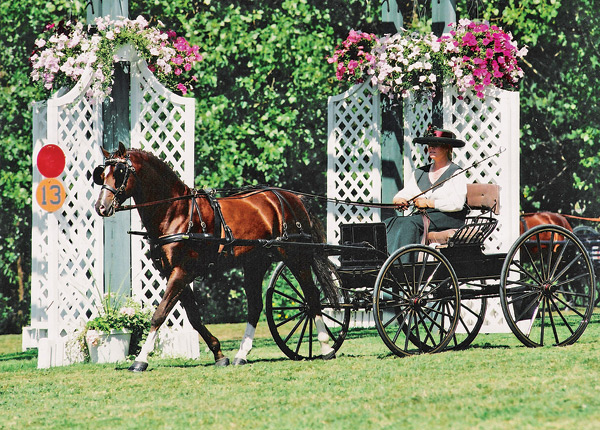
Kirsten Brunner has won several international pleasure driving championships. Photo By Ronni Nienstedt.
Rustic Meadows
Sidesaddle carries on the elegance of another age
by Kate Hawthorne
What do Catherine de Medici, Annie Oakley, and Queen Elizabeth II have in common? They all rode ‘aside’ – sidesaddle – on their mounts. The Queen still does, at major ceremonies including the Trooping of the Colour. An elegant yet rarely seen equestrian style, sidesaddle has a long history closely linked with societal “rules” for women.
Originally designed to accommodate “desired modesty”’ as well as bulky long skirts, riding sidesaddle evolved from being seated “Virgin Mary-style” aside a mount while being led by a man (as opposed to astride), to the horned saddle that allowed a woman to take up her own reins and have some autonomous control.
The nineteenth-century design breakthrough of a second horn or pommel on the saddle provided greater security and freedom and liberated women to more safely gallop and jump. That’s really when the proverbial mare left the barn and went field hunting and show jumping.
Joanne Milton of Rustic Meadows near Hillsburgh is an International Sidesaddle Organization judge and instructor, as well as a certified Western level-one EC coach. She has even giving demonstrations in Western sidesaddle for years at the Royal Winter Fair. “People who are looking for something elegant and who enjoy the fashion aspect of it will likely get into it,” she observes of the interested crowds.
The fashion aspect refers to the period costumes popular with the sport that run the gamut from ornate medieval to simple Edwardian and colourful Western. The impact of a smartly turned out, dappled grey with elegant rider perched aside in formal Victorian hunt attire, volumes of evenly spread black apron and skirts, tidy black jacket with canary vest, crisp white stock and prim black bowler are something out of a romantic novel. A little known – or practised – fact, and one guaranteed to catch the judge’s eye, riding sidesaddle is allowed in hunter classes under current EC rules.
“It makes you more conscious of your posture,” explains Milton, referring to the elegant look of the rider’s position, “because you have to keep your right shoulder back.” (If you don’t, you can “go out the back door,” that is, fall backwards off the other side).
“A lot of people will say their horses move more freely, particularly through the shoulders, under sidesaddle,” Milton adds. Moving freely also applies to the rider. “If you have bad hips or knees or lower back, it is certainly more comfortable to ride sidesaddle,” she says, speaking from experience.
Where once it took three men to help a lady mount sidesaddle (one to hold the horse, one to keep her ankles covered and one to lift her into the saddle), today’s rider uses a mounting block.
During the Stable Tour, Rustic Meadows will be offering sidesaddle demonstrations, in period costume, as well as reining demonstrations.
Equus 3D Equestrian Centre
Eventing : The iron-man challenge of the horse world
by Monica Duncan
Eventing, or combined training, has its roots in turn-of-the-century mounted military combat training. It encompasses three very different phases or disciplines that test a horse’s and rider’s courage, fitness, wits and heart.
Combining dressage (rather like the figures test in ice-skating competition), stadium jumping (where a dropped rail will cost penalty points) and cross-country endurance (where obstacles do not fall, but riders and horses may), it is considered the most dangerous – though by some the most fun – of equestrian sports. It is not for the faint of heart. Competitors must wear a fully completed medical armband for all jumping phases.
For MH (Marie Helene) Lessard, owner of Equus 3D, an eighty-acre eventing facility in Amaranth, eventing is a passion. Riding and competing since the age of eight, and now an Equine Canada (EC) Coach 2 eventing specialist, she offers training to students in dressage, jumping and cross-country skills, “but essentially the solid basics for every discipline.” She smiles and adds succinctly, “I like to give them the love of the sport and the tools to be safe and effective riders.”
Her love for the sport has evolved from her own “high level competitive eventing career” (which ended as full motherhood began) into one of teaching, coaching, mentoring and furthering the sport in every possible way she can.
A whirlwind of energy and commitment, she is an EC course conductor and mentor, co-ordinator of the Young Event Horse development program, an NCCP (National Coaching Certification Program) learning facilitator (multi-sport) “which enables me to work in French and English with coaches in all sports,” a coach and chef d’equipe with CURCA (Canadian University Riding Competitions Association), the owner and inspiration behind Equus 3D and its many programs, and in all this, a wife and mother.
Clearly the long hours are fulfilling. “Equus 3D is my passion, my home. I’ve worked really hard to make it into what it is today and I’ll continue to do so.” This year that includes hosting two horse trials (in July and September) as well as three combined (no cross-country) events.
Just as passionate about her students, Lessard says “horsemanship” is the single most important skill she teaches at every level. “Through horsemanship you learn dedication. You learn about caring for another being. You learn responsibility, accountability, reliability and all sorts of important values.” It is also the key to making her students safe and effective riders.
With those values, and a bright indoor arena (locally referred to as “the aquarium” because of all its windows), twenty horse stalls, fifty students, a supportive husband (“he’s been my number one supporter all along”) and involved sons (both boys are the demonstration riders on a new Equine Canada jumping lesson video in French), it’s clear Lessard and Equus 3D are in it for nothing less than the love of the sport.
During the Headwaters Stable Tour, Equus 3D will have live lesson demonstrations, cross-country course walks, detailed educational displays, and possibly pony rides.
Cedar Mills Riding School
Classical riding : Finding your Inner Centaur
by Monica Duncan
At Cedar Mills Riding School in Caledon, Frank Grelo’s temple of classical riding, the mantra is “calm, forward and straight.”
If you aren’t moving forward in balance, you can ask nothing of the horse. If you aren’t calm, he says, you have abandoned yourself to the “peanut brain” of the horse.
Not that the riding master doesn’t respect horses. Quite the opposite, horses are his passion, nature’s most beautiful creations. But to create artistry with the horse, to go beyond drilled technique to achieve flow, lightness and balance, a rider must attain respect from the horse. This comes from deeply cultivated self knowledge, knowledge of the horse’s mentality, as well as mechanics and discipline.
Grelo’s school horses are primarily Iberian stallions, reflecting his own training in Portugal and the European high schools of equitation. Stallions have fire and bearing, and the Iberians have a tractability that lends itself well to the classical discipline.
Every horse will naturally walk, trot and canter, and so it has been since Xenophon recorded the first principles of horsemanship around 400 bc. But the pinnacle, says Grelo is to have the horse attuned to the rider and responding with élan. Not for Grelo the training gadgets and pretty things we buy for our horses, but a highly developed bond of trust – a synergistic ride that expresses itself as sheer beauty.
Finding your “inner centaur” describes it best, says Grelo. The fusion of horse and rider is really an expression of our deepest nature and possibility, he says: “You lend me your beauty and power, I’ll lend you my mind.”
But is every rider up to this challenge? Occasionally, an average rider will surprise. “They attain the basics,” says Frank, “and suddenly a whole world of challenge and desire opens up for them.”
On this day, three students sit elegantly on their mounts. They listen attentively to the riding master as they execute half-passes and a controlled walk on a long rein.
Two stallions and a mare are working, and one stallion is keyed up by the mare’s presence. In due course the distracted stallion focusses, comes round and quietly listens to his rider. One of the three riders engages her first counter-canter after several frustrated attempts. “There is no such thing as saying ‘no’ to Frank,” she says.
Grelo’s commitment is prodigious. His school’s beautifully choreographed performances have starred at various community fundraisers and horse show events, some in his own ring. Says Grelo, “We are doing what we love, having fun and sharing it.”
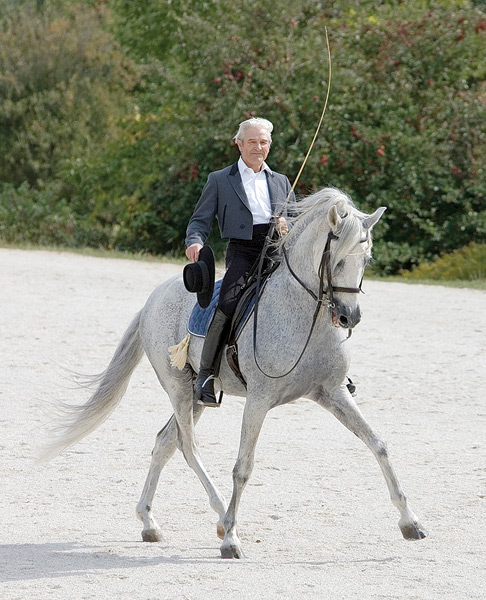
Frank Grelo on Corsario: “You lend me your beauty and power, I’ll lend you my mind.” Photo by Daniel Fernandez Photography.
Hockley Hills School of Horsemanship
The goal is to create good horse people
by Monica Duncan
“Pinch me, I’m dreaming,” says Melanie Chin. She’s head coach at Hockley Hills School of Horsemanship at Hidden Creek Farm, and she loves her job. Fifteen years after graduating from now-defunct Humber College equine studies program, the EC certified coach has created the perfect marriage of equestrian education and a caring and safe environment.
It helps, says Chin, that farm owners and quarter horse breeders, Don and Anne Fordham, are experienced in horse care and provide for school horses as quickly as a need arises. This translates to happy, healthy horses that are naturally enthusiastic and unlikely to be dodgy with riders, says Chin.
The Fordhams decided to develop a more public facility when interested people kept popping in and telling them they had created a wonderful set-up on their ninety-two-acre breeding farm. What they didn’t have was a plan to share it. Enter Melanie Chin who longed to recreate the professional and supportive horse environment she had experienced at Humber. And so a school was born to co-exist happily with the quarter horse business.
The goal is to create “good horse people,” says Chin. Students grow their confidence and riding skills on safe horses and are further encouraged to acquire knowledge of horse mentality and biomechanics.
“It’s really important that riders develop an innate sense of how their aids are feeling to the horse, and how the horse is interpreting them,” says Chin, who adds that riding a horse should eventually come as naturally as riding a bicycle.
Chin considers herself a coach and educator first and a trainer second. Students are encouraged to ride both English and Western, in a natural progression of challenges. They work towards their Ontario Equestrian Federation rider levels, learning such other important skills as lunging, transport, and bandaging.
As a trail-riding teenager, Chin became aware that not all horses were happy or well cared for, and that was her inspiration to attend Humber. With Don and Anne’s support, she has successfully created a collegial atmosphere at Hockley.
And happy, healthy horses do translate into a job well done. “We only occasionally use a crop here,” says Chin, “and you’ll never hear ‘kick ’em harder’.” With keen horses, there is simply no need.
During the stable tour, the Hockley Hills School of Horsemanship will present hands-on grooming instruction throughout each day.

